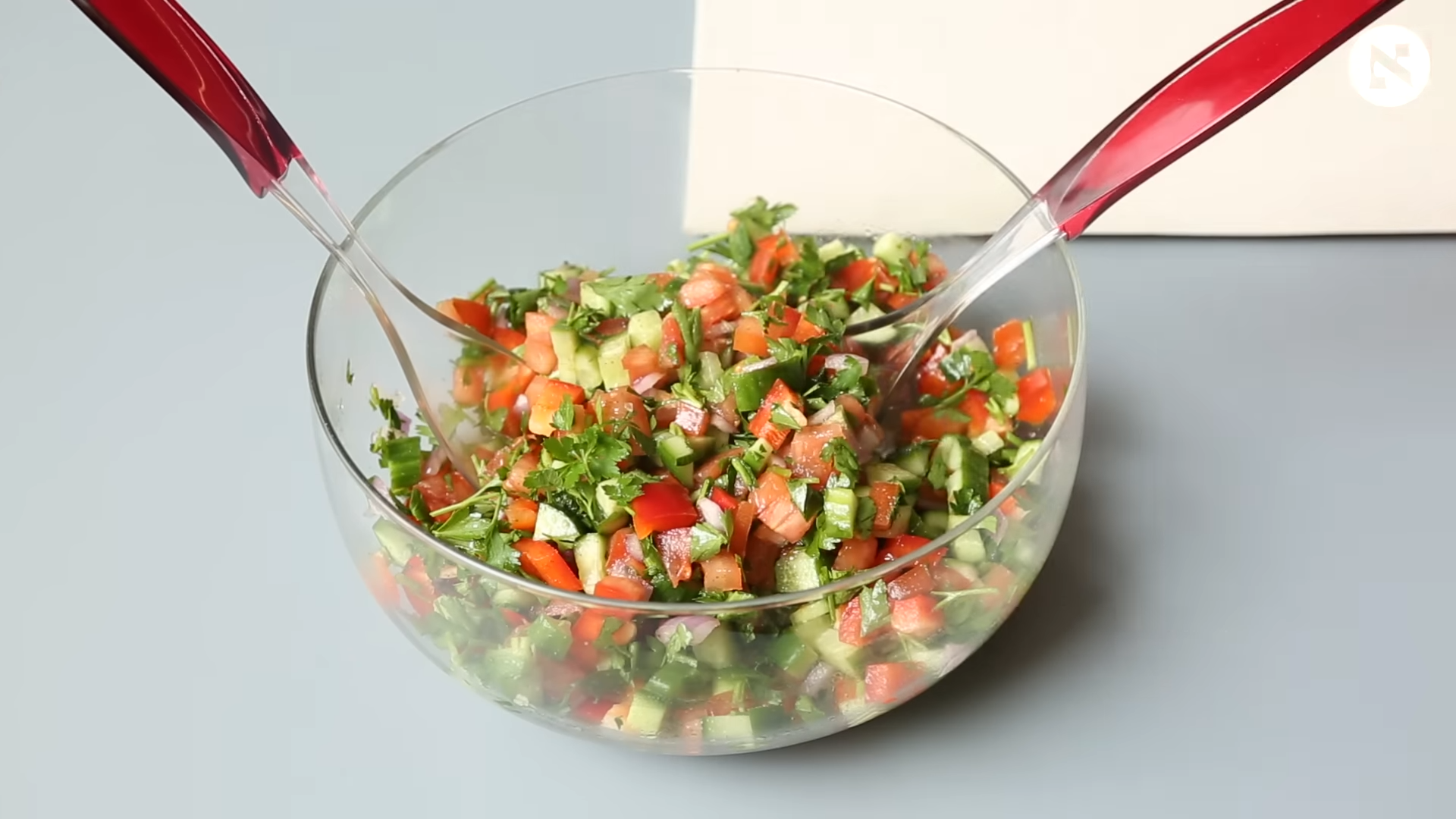Israeli Salad — For Breakfast!?
Explore the origins of this middle eastern staple and how it gained popularity in Israel
By Janna Gur
Published Oct 19, 2022

A scorching July day at the Carmel Market in Tel Aviv. Two elderly shopkeepers – sweaty tees, baseball caps – set up their lunch on an upturned produce crate.
Thickly sliced white bread, cracked green olives, a bottle of soda and a large bowl of Israeli salad – jewel-like cubes of tomatoes, cucumbers, peppers, glistening with olive oil and speckled with the vivid green of parsley. We stop to admire and are promptly invited to join in: “Come, ladies, the vegetables are market-fresh, and we chopped everything ourselves!” We decline, smiling, and explain that we are on our way to a restaurant, but suddenly a restaurant meal doesn’t feel so tempting.
On a hot afternoon at the height of Israeli summer, this salad is the perfect meal, one we would eat with hurried lusty gulps, wiping the juices with a slice of bread, or better still – drinking it tangy and warm straight from the bowl.
Israelis are a nation of salad-eaters, and are happy to call countless dishes by that name – from green salads to deli-style spreads and relishes. But, if you ask for just a salad, it will most probably be a tomato-cucumber chopped salad.
Israelis did not invent it. Similar salads are common across the Levant and the Balkans. What makes it uniquely Israeli is the way this simple salad tends to pop up at every meal – in a pita along with falafel or shawarma, on a lunch plate next to a schnitzel or a grilled chicken, with hardboiled eggs and cottage cheese for a light supper, or most notably, it is part of the Israeli breakfast.

COURTESY ארכיון מרום גולן
Most people would find starting their day with a salad a bit weird, but for Israelis this is the most natural thing in the world.
The custom of eating a chopped salad in the morning was born in a Kibbutz dining hall. The kibbutz culinary ethos spoke of simplicity – eating what you grow and connecting to local ingredients. Kibbutzniks learned how to make this simple and fresh salad from their Palestinian neighbors and made it part of their breakfast (unlike Palestinians who never start their day with a salad).
For many years, the vegetables for the salad were served whole, and each kibbutznik chopped their own salad. In time, the “kibbutz breakfast” has evolved into the famous “Israeli breakfast”, and the salad remains its hallmark, setting it apart from any other breakfast under the sun.
Want to try it for yourself? Make your own salad with this recipe from Haaretz, and use the tips below while preparing the recipe:
1. Vegetables: Must be market-fresh and packed with flavor! Tomatoes are the most crucial. Can’t find ripe, juicy tomatoes? Try cherry tomatoes – they have a longer season and are usually quite sweet. Can’t find either? Sorry guys, go for another salad. Use small Persian variety cucumbers, and make sure they are fresh and crunchy. In Israel, we don’t peel them, but if the skin is very thick, it is better to.
Tomatoes and cucumbers are the backbone of all Israeli salads, but this is just the beginning. To add crunch and flavor, add bell peppers, red onion, radishes, carrot, or even kohlrabi. Herbs are not mandatory but add beautiful aroma. Flat parsley and mint are the most popular ones. Cilantro, chives or scallions are also worth trying.
2. Seasoning: A drizzle of good, strong extra virgin olive oil, a squeeze of lemon juice, a sprinkle of salt, and a few twists of freshly ground black pepper. Sumac will add an intriguing tang. Try adding a spoonful of finely chopped lemon rind (yellow part only) or finely chopped garlic – just a bit or the flavor will be too strong.
3. Chop, Dress, Serve! 15 minutes in the fridge and the magic is gone. If you must make your salad ahead, chop the veggies, but keep the tomatoes in a separate container. Drain their juices before combining them with the rest of the ingredients. Onions, scallions or garlic should also be kept separately. Toss and season just before serving. If you store the vegetables in the fridge, take them out half an hour before making the salad to wake up the flavors.
4. Chopping: Finely chopped salad is a classic, but a chunky salad has its charm, especially if the vegetables are spectacular. Whichever method you choose, use a very sharp knife – especially for tomatoes, lest they turn mushy.
Janna Gur is a Tel Aviv-based cookbook author, journalist, speaker, and culinary expert.
Reflections
For chefs of all levels:
Make your own Israeli salad. What ingredients are you tossing together?
For breakfast enthusiasts:
What is “breakfast food”? Have you ever tried eating something for breakfast outside of the cultural norm of where you live?
For family historians:
Do you know the food history of your family recipes? Where did they originate?
Want more?
Get curated JewishArts.org content in your inbox


